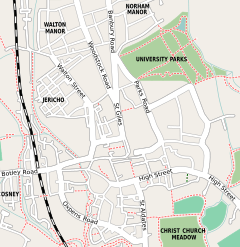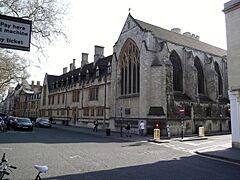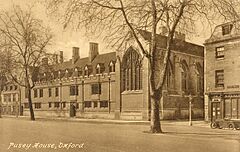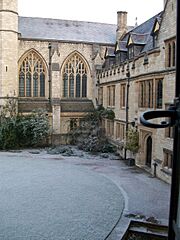Pusey House, Oxford facts for kids
Quick facts for kids Pusey House |
||||||||||||||||||
|---|---|---|---|---|---|---|---|---|---|---|---|---|---|---|---|---|---|---|
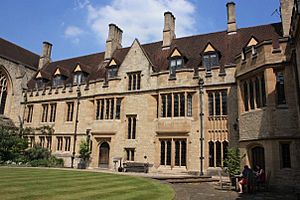 |
||||||||||||||||||
|
|
||||||||||||||||||
| Location | St Giles', Oxford, OX1 3LZ | |||||||||||||||||
| Coordinates | 51°45′24″N 1°15′37″W / 51.7567°N 1.2604°W | |||||||||||||||||
| Motto | Deus Scientiarum Dominus "The Lord is a God of Knowledge" |
|||||||||||||||||
| Founders | Henry Parry Liddon Charles Wood, 2nd Viscount Halifax Frederick Lygon, 6th Earl Beauchamp |
|||||||||||||||||
| Established | 1884 | |||||||||||||||||
| Named for | Edward Bouverie Pusey | |||||||||||||||||
| Architect | Temple Moore | |||||||||||||||||
| Principal | George Westhaver | |||||||||||||||||
| Map | ||||||||||||||||||
Pusey House is a special religious place in Oxford, United Kingdom. It's an Anglican institution, which means it's part of the Church of England. You can find it on St Giles', Oxford, a famous street in the city.
Pusey House was started in 1884 to remember Edward Bouverie Pusey. He was a professor at Oxford University and a key leader of the Oxford Movement. This movement aimed to bring back older traditions to the Church of England.
The house was created as a "House of Piety and Learning." It has a large library and a chapel, both of which are still used today. One main goal was to keep Pusey's huge collection of books safe. Over time, Pusey House has gathered many items related to Pusey and the Oxford Movement. Its library holds one of the most important collections of Anglo-Catholic materials in the country.
Pusey House holds church services every day in its chapel. It also hosts lectures and other events regularly. While it's closely linked to Oxford University, especially St Cross College, it's not a college itself.
Contents
History of Pusey House
Pusey House opened on October 9, 1884. It was built to honor Edward Bouverie Pusey. He was a professor of Hebrew at Oxford University. He was also a leading figure in the Oxford Movement for 40 years. This movement in the mid-1800s wanted the Church of England to better understand its connection to the wider Christian church.
The house was also meant to continue Pusey's work. This work focused on bringing back Catholic traditions to the Church of England. About £50,000 was raised to build the house and buy Pusey's library. This money also helped pay for clergy to look after the house and encourage religious life at the university.
The first head of Pusey House was Charles Gore. He started a religious community called the Community of the Resurrection there in 1892. This community later moved to Mirfield when Gore left in 1897.
Pusey House grew in the years that followed. It even tried out some forms of monastic life, like quiet dinners and strict schedules. Vincent Coles, who was head from 1897 to 1909, said it almost felt like a monastery.
During the time of Darwell Stone as head, a new building was planned. It was designed by Temple Moore, a famous architect. Pusey House continued to be a center for Anglo-Catholicism in Oxford. Many students, including famous people like John Betjeman and Harold Macmillan, visited.
Since 1981, a part of the Pusey House site has been used by St Cross College. They have a very long lease for the land.
Buildings and Design
From 1884 to 1912, Pusey House was in two old houses on St Giles'. But in 1903, a lawyer named John Cudworth gave £70,000. This generous gift allowed Pusey House to plan new buildings. In 1910, they bought and tore down a nearby house to make space.

The head at the time, Darwell Stone, wanted the new building to have a chapel. He asked for a "good and simple" chapel for about 200 people. He also wanted a smaller side chapel for about thirty. Other rooms needed were lecture halls, living areas, a library, and a museum. Four architects were asked to submit their designs.
After looking at all the plans, the building committee chose Temple Moore's design in 1911. Moore designed a large Gothic-style building around a courtyard. The main part was two chapels with arched ceilings. They were separated by a stone screen, similar to those in old Franciscan monasteries.
The main chapel and part of the library were finished by 1914. Most of the rest of the building was done by 1918. The south side of the courtyard was not finished when Moore died in 1920. It was completed in 1925 by John Coleridge, who followed Moore's style.
The smaller Chapel of the Blessed Sacrament was updated between 1935 and 1939. Sir Ninian Comper did this work. He added a golden canopy over the altar and stained glass in the east window. This window shows a "Tree of Jesse" to remember Pusey. It features figures of old prophets and church leaders around Christ in Majesty and the Virgin and Child. You can even see a small figure of Pusey kneeling in the window.
The Library and Archives
The Pusey House library is a huge collection of books. It has about 75,000 books on theology and history. It includes Edward Bouverie Pusey's original library. After his death, his books became the core of the collection.
Since then, the library has grown through gifts and purchases. It is now known as a leading specialist library in the United Kingdom. Besides books on the Anglo-Catholic Movement, it has collections for studying early church writings, church history, and religious practices.
The archives at Pusey House are also very important. They contain many original documents about the Oxford Movement. They also have records from Anglo-Catholic groups and religious communities. You can find letters and papers from important Anglican figures, including Pusey himself.
The collection includes papers from Henry Liddon and Sidney Leslie Ollard. There are also documents related to other notable people like William Ewart Gladstone, John Henry Newman, and John Keble.
Worship and Services
Worship in the Chapel of the Resurrection follows the Anglo-Catholic traditions of the Church of England. Everyone is welcome to attend, especially students from the university. Pusey House is known for its beautiful and traditional services. It also has a strong musical tradition, especially during the main Sunday service.
Regular Services
- Compline: A short evening prayer service held every Tuesday during term time.
- Low Mass: A daily church service held during term time. On Fridays, it follows the older Book of Common Prayer.
- Morning Prayer and Evening Prayer: These services are held daily during term time.
- Solemn High Mass: The main Sunday service, also held on major festivals during term time. The choir sings many parts of the service.
Music at Pusey House
The Choir of Pusey House has eight talented singers. Most of them are students from Oxford University college choirs. The choir sings at Sunday services during term time. They also perform at some weekday festivals and special services like carol services.
On most Sundays, the choir sings a special mass setting. This is often a polyphonic piece, meaning it has many voices singing different parts. They also sing an anthem and traditional chants. The choir's music includes old Gregorian chants and Renaissance music by composers like William Byrd and Thomas Tallis. They also perform later English church music.
Sometimes, the choir sings pieces by European composers like Louis Vierne. Pusey House even asked a composer named Alexander Campkin to write a new mass setting for its 125th anniversary. The choir has also recorded several CDs.
One special musical event is the service for King Charles the Martyr on his feast day. This service often features older Tudor and Baroque music.
The choir also goes on trips, sometimes to All Saints, Margaret Street in London. Both current and former choir members join these trips.
Pusey House has an old pipe organ. It was built in 1908 and moved to the house in 2014. The current Master of Music is Ed Gaut. Pusey House often hosts concerts and rehearsals for other music groups in Oxford.
Principals of Pusey House
- 1884–1893: Charles Gore
- 1893–1897: Robert Lawrence Ottley
- 1897–1909: Vincent Stuckey Stratton Coles
- 1909–1934: Darwell Stone
- 1934–1951: Archibald Frederic Hood
- 1951–1970: Francis Hugh Maycock
- 1970: Barry Marshall (sadly died before starting)
- 1970–1981: Cheslyn Peter Montague Jones
- 1982–2002: Philip Ursell
- 2003–2013: Jonathan Baker
- 2013–present: George Westhaver
Priest Librarians
The role of priest librarian started when Pusey House was founded in 1884. These individuals helped manage the library and its important collections.
- 1884–1897 V. S. S. Coles
- 1884–? F. E. Brightman*
- 1895–1908 H. F. B. Mackay
- 1908–1919 Darwell Stone*
- 1921–1924 Mark Carpenter-Garnier
- 1922–1923 Maurice Child
- 1927–1944 F. L. Cross*
- 1929–1937 Humphry Beevor
- 1941–1946 Eric Kemp*
- 1935–1952 Tom Parker*
- 195?–1955 Barry Marshall
- 1952–1957 Cheslyn Jones*
- 1957–1961 Robert Catling*
- 1960–1969 Donald Allchin
- 1961–1965 Rodney Hunter
- 1968–1971 & 1976-1978 Peter Cobb
- 1983–1994 Harry Smythe
- 1994–2011 William Davage
- 2001–2014 Barry Orford
Those marked with an asterisk also served as the library's main caretaker.
Notable People Connected to Pusey House
- Donald Allchin
- Jonathan Baker
- Humphrey Beevor
- John Betjeman
- Frank Edward Brightman
- Walter Carey
- Mark Carpenter-Garnier
- Maurice Child
- F. L. Cross
- Percy Dearmer
- Tom Driberg
- Austin Farrer
- Charles Gore
- Archibald Frederic Hood
- Rodney Hunter
- John Toshimichi Imai
- Cheslyn Jones
- Eric Kemp
- Margaret Heather Laird
- C. S. Lewis
- Henry Parry Liddon
- Frederick Lygon, 6th Earl Beauchamp
- Charles Abdy Marcon
- Robert MacCarthy
- Harold Macmillan
- Robert Lawrence Ottley
- Dorothy L. Sayers
- Darwell Stone
- J. R. R. Tolkien
- Cuthbert Turner
- Philip Waggett
- Evelyn Waugh
- David Williams
- Charles Wood, 2nd Viscount Halifax
Gallery
-
Pusey House from St Giles'
See also
- List of miscellaneous works by Temple Moore


